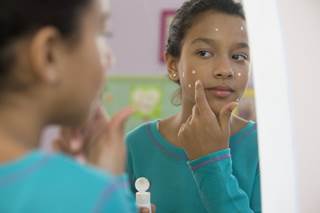
Researchers completed a post hoc analysis of 2 identically designed phase 3 trials to evaluate the efficacy, safety, and tolerability of once-daily dapsone gel, 7.5% for facial acne.
Once-daily dapsone gel, 7.5% is tolerable and effective for the treatment of facial acne in both men and women regardless of baseline lesion count, according to a study published in the Journal of Drugs in Dermatology.
Researchers completed a post hoc analysis of 2 identically designed phase 3 trials to evaluate the efficacy, safety, and tolerability of once-daily dapsone gel, 7.5% when used on facial acne with inflammatory and comedonal lesions. Both trials were 12-week, double-blind randomized studies (Clinicaltrials.gov Identifier: NCT01974141 and NCT01974323). Patients in the treatment arm used dapsone gel on the acne-affected areas once daily, whereas the patients in the control arm applied a vehicle to acne-affected areas oncedaily.
At baseline, patients were categorized into a low lesion count subgroup (50-74), medium lesion count subgroup (75-99), or high lesion count subgroup (≥100). Efficacy was measured by a reduction in the total, inflammatory, and comedonal lesions from baseline to the 12-week follow-up; safety was measured by the incidence of treatment-related adverse events; and tolerability was assessed by rating scales from both patients and clinicians.
Of the 4340 patients enrolled in both trials, 56% were women and 2160 patients were randomly assigned to the treatment arm. At baseline, 1239 patients were in the low lesion count subgroup, 640 patients were in the medium lesion count subgroup, and 281 patients were in the high lesion count subgroup.
Overall, women showed significant improvement of 56.07% in the low lesion count subgroup, 50.22% in the medium lesion count subgroup, and 47.63% in the high lesion count subgroup. Men, on the other hand, had improvements of 47.95%, 42.30%, and 34.68%, respectively.
In regards to inflammatory lesion count, there was a significant improvement among of 60.96% among women in the low lesion count subgroup, 57.91% in the medium lesion count subgroup, and 55.83% in the high lesion count subgroup. Men showed improvements of 52.75%, 46.85%, and 44.70%, respectively.
Regarding comedonal lesion count, women again had a significant improvement over men, with an improvement of 52.96% in the low lesion count subgroup, of 45.40% in the medium lesion count subgroup, and of 44.22% in the high lesion count subgroup compared with 44.67%, 39.38%, and 29.89% among men.
The incidence of treatment-related adverse events was low (18.3%), with the most commonly reported events being nasopharyngitis, headache, upper respiratory tract infection, and application site dryness and pruritus. Burning and stinging were reported by 27.5% of women and 30.3% of men and clinicians reported dryness in 19.6% of women and 15.9% of men, scaling in 16.1% of women and 12.9% of men, and erythema in 25.6% of women and 24.7% of men.
Future studies need to include comparable numbers of men and women and evaluate the relationship between the ratio of comedonal to inflammatory lesions and total lesions.
The researchers concluded “[d]apsone gel, 7.5% was shown to be safe, well tolerated, and effective in this population of females and males with acne, regardless of their baseline total lesion count” with women experiencing the greatest improvement.
Disclosure: This study was supported by Allergan plc. Please refer to reference for a complete list of authors’ disclosures.
Reference
Tanghetti EA, Harper J, Baldwin HE, Kircik LH, Bai Z, Alvandi N. Once-daily topical dapsone gel, 7.5%: effective for acne vulgaris regardless of baseline lesion count, with superior efficacy in females. J Drugs Dermatol. 2018;17(11):1192-1198.